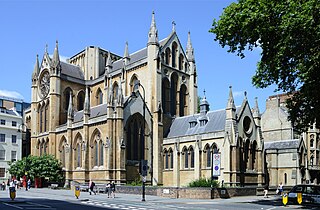
The Church of Christ the King belongs to Catholic Apostolic Church trustees; it is in Gordon Square, Bloomsbury, London. It adjoins Dr Williams's Library and is within sight of University College London. The church is used by the Anglican mission Euston Church for Sunday services and its English Chapel, at its east end, by Forward in Faith for weekday services. It has been a Grade I listed building since 10 June 1954, one of 129 such Christian buildings in London.

St. Joseph Church is parish of the Roman Catholic Church in Cumberland, Rhode Island within the Diocese of Providence. It is known for its historic campus at 1303 Mendon Road, which includes a Gothic Revival style church along with two late 19th-century, clapboard-sheathed, wood-frame structures on the east side of Mendon Road. The church and its accompanying buildings were added to the National Register of Historic Places in 1982 as St. Joseph's Church Complex.
Winterport Congregational Church, originally and once again the Winterport Union Meeting House, is a historic church at 177 Main Street in Winterport, Maine. Built in 1831, it is a prominent little-altered example of Gothic Revival architecture, designed and built by Calvin Ryder, a well-known regional architect and builder. It was listed on the National Register of Historic Places in 1973.

The Grafton Congregational Church, known locally as The Brick Church, is a historic church on Main Street in Grafton, Vermont. Built in 1833, it is a fine local example of vernacular Greek Revival and Gothic Revival religious architecture. It was listed on the National Register of Historic Places in 1979. Grafton's current Congregationalist congregation now meets primarily in the "White Church" at 55 Main Street.

The First Methodist Church of Burlington is a historic church located at 21 Buell Street in Burlington, Vermont. Built in 1869 to a design by Alexander R. Esty, it is the city's only example of ecclesiastical Romanesque Revival architecture. It was listed on the National Register of Historic Places in 1978.

The Methodist Episcopal Church of Winooski, also known as the Winooski United Methodist Church, is an historic Methodist church building located at 24 West Allen Street in Winooski, Vermont. It was built in 1918, and is a significant local example of vernacular Carpenter Gothic architecture. On March 2, 2001, it was added to the National Register of Historic Places.

Williston Congregational Church is a historic church in the center of Williston Village on United States Route 2 in Williston, Vermont. Built in 1832 and the interior restyled in 1860, this brick church is a fine local example of Gothic Revival architecture. It was listed on the National Register of Historic Places in 1973.

The Georgia Plain Baptist Church is a historic church in Georgia, Vermont. Built in 1877 for a congregation established in 1793, it is a well-preserved example of High Gothic Victorian architecture. It was listed on the National Register of Historic Places in 2001. The congregation is affiliated with the American Baptist Churches of Vermont and New Hampshire.

St. George's Catholic Church is a historic church and school building on Vermont Route 25 in Bakersfield, Vermont. Built in 1840, it housed the South Academy until 1888, when it was purchased by the Roman Catholic Diocese of Burlington. It served as a church until 1996, and has since then housed the local historical society. It is a prominent local example of Gothic Revival architecture, and was listed on the National Register of Historic Places in 2001.
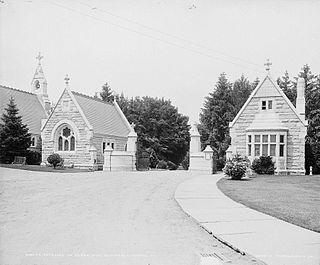
Northam Memorial Chapel and Gallup Memorial Gateway, also known as Cedar Hill Chapel and Gateway, are a historic chapel and gateway in the Cedar Hill Cemetery at 453 Fairfield Avenue in Hartford, Connecticut, USA. Although not part of that cemetery's original rural cemetery design, they are a prominent work of architect George Keller, designed in 1882 and completed in 1889. The Gothic Revival structures were listed on the National Register of Historic Places in 1982.

Brandwood End Cemetery is a cemetery located in the Brandwood ward of Birmingham, England.
The Lancaster Cemetery Chapels are the three chapels, each built to serve a different denomination, in the main cemetery of Lancaster, England. The chapels stand around a central point at the highest part of the cemetery. They were all built in 1854–55, and were designed by the local architect E. G. Paley. The chapel to the west of the central point served the Anglicans, that to the east the Non-conformists, and the chapel to the north was for Roman Catholics.

The James Stephen Hoover and Elizabeth Borland Memorial Chapel is located in Eau Claire, Wisconsin. It was added to the National Register of Historic Places in 2000 for its architectural significance.
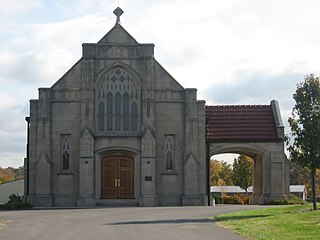
Goddard Chapel is a historic chapel located in Rose Hill Cemetery in Marion, Illinois. The chapel was constructed in 1918 through a donation from Leroy A. Goddard, who served two terms as Marion's mayor and founded the city's first bank. Chicago architect John A. Nyden designed the chapel in the Gothic Revival style. The church is built out of Bedford limestone and is topped by a red clay tile roof. The doors and windows to the church are set in a variety of Gothic arches; the doors are set within shoulder arches, the front window is in a depressed arch, and the side and back windows are set in lancet arches. The church's windows all feature stained glass designs with a lily pattern.
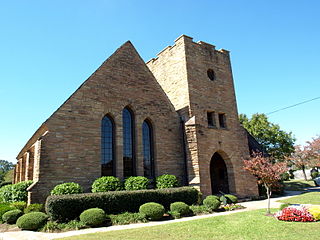
The Forrest Cemetery Chapel and Comfort Station are historic structures in Gadsden, Alabama. The chapel, comfort station, and cemetery gates were built in 1935 by workers from the Works Progress Administration, and designed by local architect Paul W. Hofferbert, who also designed the Legion Park Bowl. The chapel is designed in Gothic Revival style, with a steeply pitched gable with three lancet arched windows and a square tower with lancet arch opening for the entrance. The front gate columns and wall are connected to a hipped roof comfort building, which originally housed restrooms, but is now used for storage. All three are constructed of rough-cut sandstone blocks quarried from nearby Lookout Mountain. The buildings were listed on the Alabama Register of Landmarks and Heritage in 1988 and the National Register of Historic Places in 1992.

The Merryall Union Evangelical Society Chapel is a historic church building on Chapel Hill Road in the Lower Merryall section of New Milford, Connecticut. Built in 1890, it is the town's best example of Carpenter Gothic architecture. It is used in the summertime for services by visiting ministers of diverse denominations, and hosts weddings and other private functions. It was listed on the National Register of Historic Places in 1986.
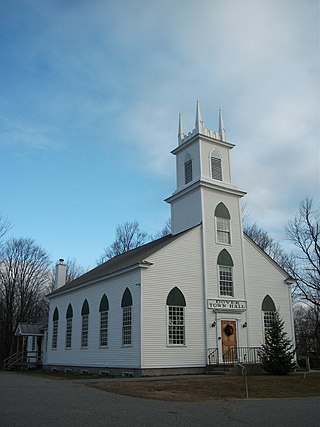
Dover Town Hall is located in the village center of Dover, Vermont, at the junction of Holland and Taft Brook Roads. Built in 1828, it is a well-preserved example of a transitional Federal-Gothic Revival church building, converted to government use in 1875. It was listed on the National Register of Historic Places in 1988.

E. C. Ryer was an American architect from Vermont, where he was one of the earliest local architects.

Lakeview Cemetery is a burial ground located off of North Avenue in Burlington, Chittenden County, Vermont. The cemetery was created in 1867 and dedicated in 1871, and overlooks Lake Champlain. It is near the current campus of Burlington High School.

All Saints' Episcopal Church is a historic Episcopal parish church in Austin, Texas, United States. Built in 1899 on the edge of the University of Texas at Austin campus, the church has long-standing connections with the university's student body and faculty. The chapel was a project of Episcopal Bishop George Herbert Kinsolving, whose crypt is located under the church. It has been designated as a City of Austin Historic Landmark since 1980 and a Recorded Texas Historic Landmark since 2014, and it was listed on the National Register of Historic Places in 2015.




















